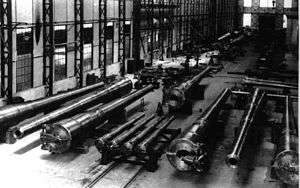Cannone navale da 381/40
| Cannone navale da 381/40 | |
|---|---|
|
381 mm guns in the Ansaldo factory | |
| Type | naval gun, coastal defense gun, railroad gun |
| Place of origin |
|
| Service history | |
| In service | 1916–45 |
| Used by |
|
| Production history | |
| Designed | 1913–16 |
| Number built | about 24 |
| Specifications | |
| Weight | 68–93.5 long tons (69.1–95.0 t) |
| Length | about 15.75 m (52 ft) |
| Barrel length | abt 15.24 m (50 ft) |
|
| |
| Shell weight | 884 kg (1,949 lb) (HE) |
| Caliber | 381 mm (15 in) |
| Breech | interrupted screw |
| Muzzle velocity | 700–770 m/s (2,297–2,526 ft/s) |
| Effective firing range | 24,000 m (78,740 ft) |
The Cannone navale da 381/40 was an Italian naval gun ordered in 1913 to equip the battleships of the Francesco Caracciolo class. The ships were cancelled in 1916 and the guns intended for them were diverted to other uses. Seven were turned over the Army and turned into railroad guns, a number were used as coast defense guns and the rest were used on monitors to provide naval gunfire support for the Army. Most of the monitors were disarmed after World War I and their guns were transferred to coastal batteries, but the railroad guns and the coast defense guns were used throughout World War II.
Development
Italy planned a class of four dreadnought battleships to succeed the two ships of the Andrea Doria class to be armed with 381 mm (15 in) guns to match the British Queen Elizabeth class. The Italians ordered thirty guns in 1913, ten each from Ansaldo-Schneider, Armstrong-Pozzvoli, and Vickers-Terni. The guns had identical ballistic performance, but differed in construction. The government favored the English design and ordered another ten in 1914 from Armstrong-Pozzvoli despite the fact that the Ansaldo guns only weighed 63 long tons (64 t) compared to the Armstrong's 84 long tons (85 t).[1]
The gun fired an 884 kg (1,949 lb) armor-piercing at a muzzle velocity of 700 m/s (2,297 ft/s) to a range of 19,800 m (64,961 ft) at an elevation of 20°. Mounts that were altered to allow 30° elevation had a maximum range of 27,300 m (89,567 ft). The rate of fire depended on the mount, but did not exceed 1.5–2 rounds per minute.[2]
The Francesco Caracciolo class were laid down in 1914–15, but the entry of Italy into World War I in 1915 forced her to suspend construction in favor of higher-priority construction and because of material shortages. This freed up their guns to be used for other purposes.
Repurposed
Railroad guns
Seven of the Ansaldo guns were transferred to the Army and turned into railroad guns. The gun plus its mount weighed 212 tonnes (209 long tons; 234 short tons) and was 24.5 metres (80 ft) long. The gun could elevate to a maximum of 25° and it could traverse 2° on its mount. It fired high explosive shells weighing 730 kg (1,609 lb) and 876 kg (1,931 lb) to ranges of 33.6 km (21 mi) and 30 km (19 mi) respectively. It also fired a 884.5 kg (1,950 lb) armor-piercing shell to a range of 30 km (19 mi).[3]
The guns were delivered during 1916–17, but little is known about their service in World War I. They served into World War II, but, again, little is known of their service.[4]
Naval guns
Two Ansaldo guns were mounted on the monitor Faà di Bruno in 1917.
Coast defense guns
A Twin turret was installed at Almalfi Battery on the Cavallino coast (North East of Venice) during World War 1, becoming operational in May 1917.[5]
See also
Weapons of comparable role, performance and era
- BL 15 inch Mk I naval gun : British naval equivalent
- 38 cm SK L/45 "Max" : German naval and land equivalent
References
- ↑ Clerici, et al., pp. 151–52
- ↑ "Italian 381 mm/40 (15") Model 1914". 9 October 2006. Retrieved 18 November 2009.
- ↑ Kosar, p. 234
- ↑ Clerici, et al., p. 154
- ↑ "The Amalfi Battery during the Great War". Retrieved 27 October 2011.
Bibliography
- Campbell, John (2002). Naval Weapons of World War Two. London: Conway Maritime Press. ISBN 0-87021-459-4.
- Clerici, Carlo; Robbins, Charles B.; Flocchini, Alfredo (1999). "The 15" (381mm)/40 Guns of the Francesco Caracciolo Class Battleships". Warship International (Toledo, OH: International Naval Research Organization) 36 (2): 151–157. ISSN 0043-0374.
- Gardiner, Robert; Gray, Randal, eds. (1984). Conway's All the World's Fighting Ships: 1906-1922. Annapolis: Naval Institute Press. ISBN 0-85177-245-5.
- Kosar, Franz (1999). Eisenbahngeschütz der Welt. Stuttgart: Motorbuch. ISBN 3-613-01976-0.
External links
- The Amalfi Battery
- http://www.fortificazioni.net/VENEZIA/batteria_amalfi.htm Italian language site
- Schneider et Compagnie. Atelier d'artillerie. - Matériel d'artillerie navale : Marine Royale Italienne : tirs de précision d'un canon de 381 mm de 40 calibres, effectués au Polygone du Hoc le 24 juillet 1914, en présence de la Commission de la Marine Royale Italienne, présidée par son Excellence M. l'Amiral Bertolini
| ||||||||||||||||||||||||||||||
